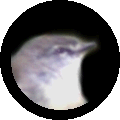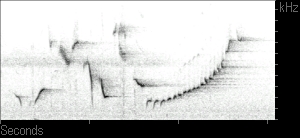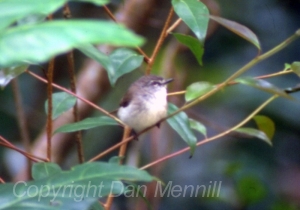 Mountain
Thornbill
Mountain
Thornbill Acanthiza katherina
 Figure 1.
Spectrogram of the Mountain Thornbill song.
Figure 1.
Spectrogram of the Mountain Thornbill song.
(The fourth song bout from the sound file is depicted.)

Mountain Thornbill - Acanthiza katherina
Although mountain thornbills have a drab grey and brown appearance, however they are some of the most noticeable birds in the Atherton Tablelands rainforest because of their phenomenal voices. Although they weigh only 10 grams, mountain thornbills are among the giants of the birdsong world in terms of their extended vocal range, syllabic diversity, and speed of song delivery.
Pizzey and Knight suggest that thornbill songs include trills, fussy squeaks and churrs, and zizzing solding. The talkative blips and squeaks of mountain thornbills remind me of the chattering of R2-D2 from Star Wars. Mountain thornbills sing across a very large frequency range, from 1000 to 9000 Hz, and are adept at jumping quickly between high frequencies and low frequencies. The most spectacular part of mountain thornbill songs are the rapidly ascending series of bubbly notes, as you can hear in the fourth and last songs in the sound file (pictured in Figure 1). With such a great diversity of syllable types and such a varied use of the frequency spectrum, mountain thornbill songs may contain a tremendous amount of information. However, the behaviour of mountain thornbills remains to be studied.
Habitat.
Mountain thornbills are found in wet forests and woody creeks at elevations of 450 meters and higher.
Range.
Mountain thornbills are endemic to the highlands of northeast Queensland, Australia.
Further Reading.
G. Pizzey & F. Knight. 1999.
Field
guide to the birds of Australia. Harper Collins, Sydney.
No recordings, photographs, or other information may be used without written permission (email me at dmennill AT uwindsor DOT ca).